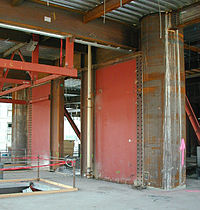
Photo from wikipedia
Abstract Steel plate shear wall (SPSW) with regularly spaced circular perforations has recently been developed. While the current edition of AISC 341-16 and CSA S16-14 have adopted perforated SPSW (P-SPSW)… Click to show full abstract
Abstract Steel plate shear wall (SPSW) with regularly spaced circular perforations has recently been developed. While the current edition of AISC 341-16 and CSA S16-14 have adopted perforated SPSW (P-SPSW) in their design standards, no simple numerical model is currently available for analyzing this SPSW system. A reliable macro-model is developed for regularly spaced circular perforations. The proposed macro-model is validated against available experimental results. Performance of three multi-storey (4-, 7-, and 10-storey) perforated SPSWs designed according to CSA S16-14 and NBCC 2015 is further investigated through conducting a series of time history analyses using a suite of 44 ground motions developed for western Canada. When compared with seismic analysis results of solid SPSWs, it is observed that the median shear envelopes for P-SPSWs are slightly less than that for solid ones. Also, in comparison to solid SPSW archetypes, the contribution of boundary columns in resisting the storey shear is found higher than the infill plate in most of the stories in P-SPSW archetypes. Finally, a sensitivity assessment is performed to evaluate the effect of perforation diameter on different responses of P-SPSWs, such as peak column axial forces, peak column bending moments, and maximum interstorey drift. It is observed that with an increase in the hole diameter, column axial force demand decreases, while the bending moment remains almost the same. Also, since adding perforations to the infill plate reduces the stiffness and strength of the P-SPSW system, the interstorey drift ratio is increased in comparison to solid SPSW.
Journal Title: Thin-walled Structures
Year Published: 2021
Link to full text (if available)
Share on Social Media: Sign Up to like & get
recommendations!